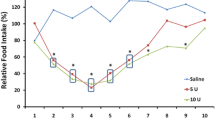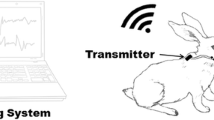Abstract
Background
It has been reported that botulinum toxin type A (BoNT-A) produces structural changes in masticatory muscles. However, not all histomorphometric parameters affected by BoNT-A parameters have been assessed. This study investigated the histomorphometric changes in the masseter muscle of rats after a single injection of BoNT-A.
Methods
Forty-four adult animals were randomly divided into control group (n = 22) and BoNT-A group (n = 22). Controls received a single dose of 0.14 mL/kg of saline in masseter muscles, and the BoNT-A group received a 7 U/Kg of BoNT-A. The groups received the same volume of injected substances. Animals were sacrificed on 7th (n = 5), 14th (n = 5), 21st (n = 5), 28th (n = 4) and 90th (n = 3) days post-treatment. Histological masseter tissue slides were obtained from hematoxylin–eosin treatment and analyzed in optical microscopy regarding muscle cross-sectional area, amount of connective tissue and quantity and diameter of myocytes. For statistical analysis, generalized linear models were used to compare the data (ANOVA). In all test, the significance level of 5% was set.
Results
BoNT-A values of cross-sectional area of the masseter muscle were significantly lower than controls (p < 0.01) throughout the study. Regarding myocytes quantity, BoNT-A subgroups presented higher values than controls (p < 0.0001) since the 14th day until the end of the study; however, the diameter of myocytes was smaller in all BoNT-A subgroups (p < 0.0001) in all assessment points. The amount of connective tissue was higher in BoNT-A subgroups (p < 0.0001) throughout the study.
Conclusion
A single injection of BoNT-A altered the structure of masseter muscle of rats, regarding its histomorphometric parameters.
No Level Assigned
This journal requires that authors assign a level of evidence to each article. For a full description of these Evidence-Based Medicine ratings, please refer to the Table of Contents or the online Instructions to Authors www.springer.com/00266.

Similar content being viewed by others
Data Availability
Datasets related to this article will be available upon request to the corresponding author.
References
Matak I, Lacković Z (2014) Botulinum toxin A, brain and pain. Prog Neurobiol 119–120:39–59
Muñoz Lora VRM, Del Bel Cury AA, Jabbari B et al (2019) Botulinum toxin type A in dental medicine. J Dent Res 98(13):1450–1457
Matak I, Bölcskei K, Bach-Rojecky L et al (2019) Mechanisms of botulinum toxin type A action on pain. Toxins (Basel) 11(8):459
Coté TR, Mohan AK, Polder JA et al (2005) Botulinum toxin type A injections: adverse events reported to the US food and drug administration in therapeutic and cosmetic cases. J Am Acad Dermatol 53(3):407–415
De la Torre CG, Poluha RL, Lora VM et al (2019) Botulinum toxin type A applications for masticatory myofascial pain and trigeminal neuralgia: what is the evidence regarding adverse effects? Clin Oral Investig 23(9):3411–3421
Dressler D, Saberi FA, Barbosa ER (2005) Botulinum toxin: mechanisms of action. Arq Neuropsiquiatr 63(1):180–185
Dutton JJ (1996) Botulinum-A toxin in the treatment of craniocervical muscle spasms: short- and long-term, local and systemic effects. Surv Ophthalmol 41(1):51–65
Brin MF (1997) Botulinum toxin: chemistry, pharmacology, toxicity, and immunology. Muscle Nerve Suppl 6:S146–S168
Moon YM, Kim MK, Kim SG et al (2016) Apoptotic action of botulinum toxin on masseter muscle in rats: early and late changes in the expression of molecular markers. Springerplus 5(1):991
Balanta-Melo J, Toro-Ibacache V, Torres-Quintana MA et al (2018) Early molecular response and microanatomical changes in the masseter muscle and mandibular head after botulinum toxin intervention in adult mice. Ann Anat 216:112–119
Tsai CY, Lin YC, Su B et al (2012) Masseter muscle fibre changes following reduction of masticatory function. Int J Oral Maxillofac Surg 41(3):394–399
Fortuna R, Vaz MA, Youssef AR et al (2011) Changes in contractile properties of muscles receiving repeat injections of botulinum toxin (Botox). J Biomech 44(1):39–44
De la Torre CG, Alvarez-Pinzon N, Muñoz-Lora VRM et al (2020) Efficacy and safety of botulinum toxin type A on persistent myofascial pain: a randomized clinical trial. Toxins (Basel) 12(6):395
Shome D, Khare S, Kapoor R (2019) Efficacy of botulinum toxin in treating Asian Indian patients with masseter hypertrophy: a 4-year follow-up study. Plast Reconstr Surg 144(3):390e-e396
Park HU, Kim BI, Kang SM et al (2013) Changes in masticatory function after injection of botulinum toxin type A to masticatory muscles. J Oral Rehabil 40(12):916–922
Kün-Darbois JD, Libouban H, Chappard D (2015) Botulinum toxin in masticatory muscles of the adult rat induces bone loss at the condyle and alveolar regions of the mandible associated with a bone proliferation at a muscle enthesis. Bone 77:75–82
Moon YM, Kim YJ, Kim MK et al (2015) Early effect of Botox-A injection into the masseter muscle of rats: functional and histological evaluation. Maxillofac Plast Reconstr Surg. 37(1):46
Zimmermann M (1983) Ethical guidelines for investigations of experimental pain in conscious animals. Pain 16(2):109–110
Lora VR, Clemente-Napimoga JT, Abdalla HB et al (2017) Botulinum toxin type A reduces inflammatory hypernociception induced by arthritis in the temporomadibular joint of rats. Toxicon 129:52–57
Turner NJ, Badylak SF (2012) Regeneration of skeletal muscle. Cell Tissue Res 347(3):759–774
Cao RY, Li J, Dai Q et al (2018) Muscle atrophy: present and future. Adv Exp Med Biol 1088:605–624
Kim HJ, Jeon BS, Lee KW (2000) Hemimasticatory spasm associated with localized scleroderma and facial hemiatrophy. Arch Neurol 57(4):576–580
Shenkman BS, Turtikova OV, Nemirovskaya TL et al (2010) Skeletal muscle activity and the fate of myonuclei. Acta Naturae. 2(2):59–66
Dumont NA, Bentzinger CF, Sincennes MC et al (2015) Satellite cells and skeletal muscle regeneration. Compr Physiol 5(3):1027–1059
Ito R, Higa M, Goto A et al (2018) Activation of adiponectin receptors has negative impact on muscle mass in C2C12 myotubes and fast-type mouse skeletal muscle. PLoS ONE 13(10):e0205645
Addison WN, Hall KC, Kokabu S et al (2019) Zfp423 regulates skeletal muscle regeneration and proliferation. Mol Cell Biol. https://doi.org/10.1128/MCB.00447-18
Zammit PS, Golding JP, Nagata Y et al (2004) Muscle satellite cells adopt divergent fates: a mechanism for self-renewal? J Cell Biol 166(3):347–357
Rantanen J, Hurme T, Lukka R et al (1995) Satellite cell proliferation and the expression of myogenin and desmin in regenerating skeletal muscle: evidence for two different populations of satellite cells. Lab Invest 72(3):341–347
Ten Broek RW, Grefte S, Von den Hoff JW (2010) Regulatory factors and cell populations involved in skeletal muscle regeneration. J Cell Physiol 224(1):7–16
Morgan JE, Partridge TA (2003) Muscle satellite cells. Int J Biochem Cell Biol 35(8):1151–1156
Hwang JH, Ra YJ, Lee KM et al (2006) Therapeutic effect of passive mobilization exercise on improvement of muscle regeneration and prevention of fibrosis after laceration injury of rat. Arch Phys Med Rehabil 87(1):20–26
Acknowledgments
The authors acknowledge the Coordenação de Aperfeiçoamento de Pessoal de Nível Superior—Brasil (CAPES) for the PhD scholarship of D.M.R.—grant code 001 and the Sao Paulo Research Foundation—FAPESP for the post-doctoral scholarship of G. D. T. C. (grant 2017/21674-0).
Author information
Authors and Affiliations
Corresponding author
Ethics declarations
Conflict of interest
The authors declare that they have no conflicts of interest to disclose.
Informed Consent
For this type of study, informed consent is not required.
Institutional Review Board Statement
The present study was approved by the Ethics Committee in Animals Research of the State University of Campinas (CEUA/UNICAMP), Sao Paulo, Brazil under protocol no. 4554-1/2017 and followed the National Council for Control of Animal Experimentation (CONCEA). All applicable institutional and/or national guidelines for the care and use of animals were followed.
Additional information
Publisher's Note
Springer Nature remains neutral with regard to jurisdictional claims in published maps and institutional affiliations.
Rights and permissions
Springer Nature or its licensor (e.g. a society or other partner) holds exclusive rights to this article under a publishing agreement with the author(s) or other rightsholder(s); author self-archiving of the accepted manuscript version of this article is solely governed by the terms of such publishing agreement and applicable law.
About this article
Cite this article
Ramos, D.M., de Brito Silva, R., De la Torre Canales, G. et al. Histomorphometric Changes of the Masseter Muscle of Rats After a Single Injection of Botulinum Toxin Type A. Aesth Plast Surg 48, 1037–1044 (2024). https://doi.org/10.1007/s00266-023-03572-z
Received:
Accepted:
Published:
Issue Date:
DOI: https://doi.org/10.1007/s00266-023-03572-z




